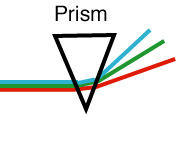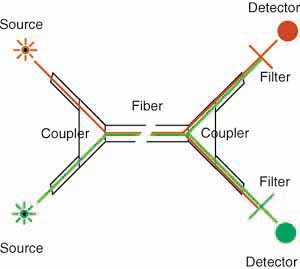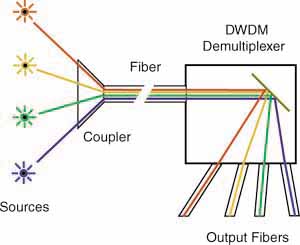

Why Is WDM Used?
With the exponential growth in communications, caused mainly by the wide acceptance of the Internet, many carriers are finding that their estimates of fiber needs have been highly underestimated. Although most cables included many spare fibers when installed, this growth has used many of them and new capacity is needed. Three methods exist for expanding capacity: 1) installing more cables, 2) increasing system bitrate to multiplex more signals or 3) wavelength division multiplexing.
Installing more cables will be the preferred method in many cases, especially in metropolitan areas, since fiber has become incredibly inexpensive and installation methods more efficient (like mass fusion splicing.) But if conduit space is not available or major construction is necessary, this may not be the most cost effective.
Increasing system bitrate may not prove cost effective either. Many systems are already running at SONET OC-48 rates (2.5 GB/s) and upgrading to OC-192 (10 GB/s) is expensive, requires changing out all the electronics in a network, and adds 4 times the capacity, more than may be necessary.
The third alternative, wavelength division multiplexing (WDM), has proven more cost effective in many instances. It allows using current electronics and current fibers, but simply shares fibers by transmitting different channels at different wavelengths (colors) of light. Systems that already use fiber optic amplifiers as repeaters also do not require upgrading for most WDM systems.
How Does WDM Work?
It is easy to understand WDM. Consider the fact that you can see many different colors of light - reg, green, yellow, blue, etc. all at once. The colors are transmitted through the air together and may mix, but they can be easily separated using a simple device like a prism, just like we separate the "white" light from the sun into a spectrum of colors with the prism.

Figure 1. Separating a beam of light into its colors
This technique was first demonstrated with optical fiber in the early 80s when telco fiber optic links still used multimode fiber. Light at 850 nm and 1300 nm was injected into the fiber at one end using a simple fused coupler. At the far end of the fiber, another coupler split the light into two fibers, one sent to a silicon detector more sensitive to 850 nm and one to a germanium or InGaAs detector more sensitive to 1300 nm. Filters removed the unwanted wavelengths, so each detector then was able to receive only the signal intended for it.

Figure 2. WDM with couplers and filters
By the late 80s, all telecom links were singlemode fiber, and coupler manufactures learned how to make fused couplers that could separate 1300nm and 1550 nm signals adequately to allow WDM with simple, inexpensive components. However, these had limited usefulness, as fiber was designed differently for 1300nm and 1550 nm, due to the dispersion characteristics of glass. Fiber optimized at 1300 nm was used for local loop links, while long haul and submarine cables used dispersion-shifted fiber optimized for performance at 1550 nm. This simple version of WDM is widely used in fiber to the home (FTTH) applications. Signals are sent downstream to the subscriber at 1490 nm (and 1550 for analog CATV if used) and upstream at 1310n.
With the advent of fiber optic amplifiers for repeaters in the late 80s, emphasis shifted to the 1550 nm transmission band. WDM only made sense if the multiplexed wavelengths were in the region of the fiber amplifiers operating range of 1520 to 1560 nm. It was not long before WDM equipment was able to put 4 signals into this band, with wavelengths about 10 nm apart.
The input end of a WDM system is really quite simple. It is a simple coupler that combines all the inputs into one output fiber. These have been available for many years, offering 2, 4, 8, 16, 32 or even 64 inputs. It is the demultiplexer that is the difficult component to make.

Figure 3. WDM demultiplexer
The demultiplexer takes the input fiber and collimates the light into a narrow, parallel beam of light. It shines on a grating (a mirror like device that works like a prism, similar to the data side of a CD) which separates the light into the different wavelengths by sending them off at different angles. Optics capture each wavelength and focuses it into a fiber, creating separate outputs for each separate wavelength of light.
WDM to DWDM
Current systems offer from 4 to 32 channels of wavelengths. The higher numbers of wavelengths has lead to the name Dense Wavelength Division Multiplexing or DWDM. The technical requirement is only that the lasers be of very specific wavelengths and the wavelengths are very stable, and the DWDM demultiplexers capable of distinguishing each wavelength without crosstalk.
Advantages of WDM
A WDM system has some features that make them very useable. Each wavelength can be from a normal link, for example a OC-48 link, so you do not obsolete most of your current equipment. You merely need laser transmitterss chosen for wavelengths that match the W
DM demultiplexer to make sure each channel is properly decoded at the receiving end.
If you use an OC-48 SONET input, you can have 4X2.5 GB/s = 10 GB/s up to 32 X 2.5 GB/s = 80 GB/s. While 32 channels are the maximum today, future enhancements are expected to offer 80-128 channels!
And you are not limited to SONET, you can use Gigabit Ethernet for example, or you can mix and match SONET and Gigabit Ethernet or any other digital signals! You can even mix in analog channels like CATV, as is done with BPON FTTH systems.
Repeaters
Another technology that facilitates DWDM is the development of
fiber optic amplifiers for use as repeaters. They can amplify numerous wavelengths of light simultaneously, as long as all are in the wavelength range of the FO amplifier. They work best in the range of 1520-1560 nm, so most DWDM systems are designed for that range. Now that fiber has been made with less effect from the OH absorption bands at 1400 nm and 1600 nm, the possible range of DWDM has broadened considerably. Technology needs development for wider range fiber amplifiers to take advantage of the new fibers.
Applications
Two obvious applications are already in use, submarine cables and extending the lifetime of cables where all fibers are being used. For submarine cables, DWDM enhances the capacity without adding fibers, which create larger cables and bulkier and more complicated repeaters. Adding service in areas where cables are now full is another good application.
But this technology may also reduce the cost on all land-based long distance communications links and new technology may lead to totally new network architectures.
Further Enhancements
Imagine an all-optical network that uses DWDM, switches signals in the optical domain without converting signals to electronics, and can add or drop signals by inserting or withdrawing wavelengths at will. All this is being researched right now, and given the speed with which optical technology advances, an all-optical network may not be far in the future!
CWDM
Coarse wavelength-division multiplexing is another variant of WDM. Generally CWDM refers to using lasers spaced 20 nm apart over the full range of 1260 to 1670 nm. It only works on low water peak fibers, where the high water absorption bands have been eliminated in the manufacture of the fiber.
Note: The article is from The Fiber Optic Association www.thefoa.org, edited by Elena.